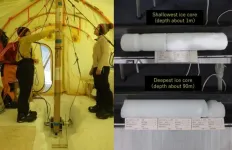Kidney cancer risks higher for Hispanic, Native Americans in Arizona
2021-05-06
(Press-News.org) Recently published research from the University of Arizona Health Sciences shows that advanced-stage kidney cancer is more common in Hispanic Americans and Native Americans than in non-Hispanic whites, and that both Hispanic Americans and Native Americans in Arizona have an increased risk of mortality from the disease.
"We knew from our past research that Hispanic Americans and Native Americans have a heavier burden of kidney cancer than non-Hispanic whites," said Ken Batai, PhD, a Cancer Prevention and Control Program research member at the UArizona Cancer Center and research assistant professor of urology in the College of Medicine - Tucson. "But we also know that around 90% of the Hispanic population in Arizona is Mexican American - either U.S.-born or Mexican-born - and we do not think this subgroup is well-represented in the national data."
With funding from the National Cancer Institute, Dr. Batai led a team of UArizona Cancer Center researchers that examined data from the National Cancer Database and the Arizona Cancer Registry to look for disparities in surgical treatment of kidney cancer. They also investigated the possibility that delayed treatments may result in advanced-stage kidney cancer, which has been associated with high mortality rates in Hispanic Americans and Native Americans.
The paper, "Renal Cell Carcinoma Health Disparities in Stage and Mortality among American Indians/Alaska Natives and Hispanic Americans: Comparison of National Cancer Database and Arizona Cancer Registry Data," was published in the journal Cancers.
The study found that Arizona's Hispanic Americans are about two times more likely than non-Hispanic white people to have advanced-stage kidney cancer and have nearly a two times higher risk of mortality from early-stage kidney cancer. Similarly, Native Americans are about 30% more likely to have advanced-stage kidney cancer and face a 30% increased risk of mortality from early-stage kidney cancer.
These findings suggest that observed disparities in kidney cancer mortality risk cannot be explained by delays in treatment.
The researchers utilized state data to organize Hispanic Americans into various subgroups, including U.S.-born Mexican Americans. They determined this group to have a three times higher risk of mortality compared with non-Hispanic white Americans. National cancer statistics do not break down subgroups within the general Hispanic population, thus risks to U.S.-born Mexican Americans living in Arizona may be understated in national reporting.
Dr. Batai attributes the discrepancy in national versus state data to the data-collection process. The National Cancer Database relies on hospital-based reporting, whereas the state registry is population-based. Many small hospitals and clinics in rural settings may not report to the National Cancer Database, which could explain the misrepresentation of Hispanic Americans in Arizona.
"To this point, there has been no research documenting this disparity in Hispanic Americans," Dr. Batai said. "This can be very useful information to share with primary care providers and urologists who may not yet be aware."
"Carefully documenting these disparities is something that distinguishes us as a comprehensive cancer center," said Joann Sweasy, PhD, Cancer Center director and inaugural holder of the Nancy C. and Craig M. Berge Endowed Chair. "Dr. Batai is embedded in our center not only in prevention, but he is also a part of our genitourinary clinical research team. This research benefits both perspectives, which are critical for us to meet the needs of our patients."
The research could drive further investigation into why Arizona's Hispanic and Native American populations face increased risks from kidney cancer.
"We know these populations also have higher prevalence of diabetes and blood pressure, both of which are risk factors for kidney cancer," Dr. Batai said. "While we continue to explore differences in kidney cancer surgical treatment across these groups, we are investigating if there are biologic bases in kidney cancer disparities."
INFORMATION:
ELSE PRESS RELEASES FROM THIS DATE:
2021-05-06
The air in the United States and Western Europe is much cleaner than even a decade ago. Low-sulfur gasoline standards and regulations on power plants have successfully cut sulfate concentrations in the air, reducing the fine particulate matter that harms human health and cleaning up the environmental hazard of acid rain.
Despite these successes, sulfate levels in the atmosphere have declined more slowly than sulfur dioxide emissions, especially in wintertime. This unexpected phenomenon suggests sulfur dioxide emission reductions are less efficient than expected for cutting sulfate aerosols. A new study led by Tokyo Institute of Technology (Tokyo Tech), Hokkaido University and the University ...
2021-05-06
The ability of antibodies to recognize specific cancer cells is used in oncology to specifically target those cells with small active agents. Research published in the journal Angewandte Chemie shows that scientists have now built a transport system that delivers even large protein-based drugs into cancer cells. This study demonstrates how proteins can arrive at their target intact, protected from destructive proteases by polymer brushes.
Developing anticancer treatments involves two recurring problems for researchers. An active agent needs to be able to kill the body's cells at the root of the cancer, and it should be active in target cancer cells rather than in healthy cells. Many medical researchers ...
2021-05-06
When you save an image to your smartphone, those data are written onto tiny transistors that are electrically switched on or off in a pattern of "bits" to represent and encode that image. Most transistors today are made from silicon, an element that scientists have managed to switch at ever-smaller scales, enabling billions of bits, and therefore large libraries of images and other files, to be packed onto a single memory chip.
But growing demand for data, and the means to store them, is driving scientists to search beyond silicon for materials that can push memory devices to higher densities, ...
2021-05-06
For millennia, humans in the high latitudes have been enthralled by auroras--the northern and southern lights. Yet even after all that time, it appears the ethereal, dancing ribbons of light above Earth still hold some secrets.
In a new study, physicists led by the University of Iowa report a new feature to Earth's atmospheric light show. Examining video taken nearly two decades ago, the researchers describe multiple instances where a section of the diffuse aurora--the faint, background-like glow accompanying the more vivid light commonly associated with auroras--goes dark, as if scrubbed by a giant blotter. Then, after a short period of time, the blacked-out section suddenly reappears.
The researchers say the behavior, which they call "diffuse ...
2021-05-06
New research published in Experimental Physiology highlight the possible long term health impacts of COVID-19 on young, relatively healthy adults who were not hospitalized and who only had minor symptoms due to the virus.
Increased stiffness of arteries in particular was found in young adults, which may impact heart health, and can also be important for other populations who may have had severe cases of the virus. This means that young, healthy adults with mild COVID-19 symptoms may increase their risk of cardiovascular complications which may continue for some time after COVID-19 infection.
While SARS-CoV-2, the virus known ...
2021-05-06
Just as people keep their houses clean and clutter under control, a crew of cells in the body is in charge of clearing the waste the body generates, including dying cells. The housekeeping cells remove unwanted material by a process called phagocytosis, which literally means 'eating cells.' The housekeepers engulf and ingest the dying cells and break them down to effectively eliminate them.
"Phagocytosis is very important for the body's health," said Dr. Zheng Zhou, whose lab at Baylor College of Medicine has been studying phagocytosis for many years and provided key new insights into this essential process. "When this cell-eat-cell process fails, the dying cells will lose their integrity, break down and release their content into the surrounding tissues. Dumping the ...
2021-05-06
St. Jude Children's Research Hospital scientists have developed an integrated, high-throughput system to better understand and possibly manipulate gene expression for treatment of disorders such as sickle cell disease and beta thalassemia. The research appears today in the journal Nature Genetics.
Researchers used the system to identify dozens of DNA regulatory elements that act together to orchestrate the switch from fetal to adult hemoglobin expression. The method can also be used to study other diseases that involve gene regulation.
Regulatory elements, also called genetic switches, are scattered throughout non-coding regions of DNA. ...
2021-05-06
Retinoblastoma starts in the retina, the thin membrane at the back of the eye. Most patients are infants or toddlers when their cancer is found. Without treatment, the cancer spreads. Thanks to chemotherapy, surgery and other treatments, 96% of patients survive.
St. Jude researchers studied how survivors fared years later at home and at school. A previous St. Jude study of 98 retinoblastoma survivors found that their early learning and life skills declined from diagnosis to age 5.
Researchers tested 78 of the same survivors five years later. The results were more upbeat. By age 10, almost all the children functioned within the normal range ...
2021-05-06
Asthma attacks account for almost 50 percent of the cost of asthma care which totals $80 billion each year in the United States. Asthma is more severe in Black and Hispanic/Latinx patients, with double the rates of attacks and hospitalizations as the general population.
When the COVID-19 pandemic swept over the United States, a series of reports suggested that fewer people were coming to emergency departments for all sorts of medical problems, including asthma attacks and even heart attacks. In the case of asthma, it was not clear if the drop was due to people avoiding emergency services or due to better asthma control. A new analysis from investigators at Brigham and Women's Hospital shines new light on this question. In a report of ...
2021-05-06
Vaccination dramatically reduced COVID-19 symptomatic and asymptomatic infections in St. Jude Children's Research Hospital employees compared with their unvaccinated peers, according to a research letter that appears today in the Journal of the American Medical Association.
The study is among the first to show an association between COVID-19 vaccination and fewer asymptomatic infections. When the Pfizer-BioNTech BNT162b2 vaccine was authorized for use in the U.S., the vaccine was reported to be highly effective at preventing laboratory-confirmed COVID-19. Clinical trial data suggested that the two-dose regimen ...
LAST 30 PRESS RELEASES:
[Press-News.org] Kidney cancer risks higher for Hispanic, Native Americans in Arizona



